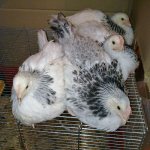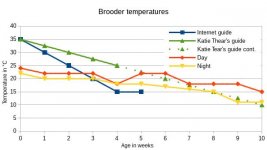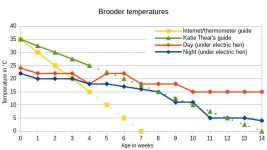KittyKat
New member
Hi all, back in warm September I was about to set my first eggs for hatching and had some questions about incubators. Marigold reminded me that it would be a good idea to follow up on that hatch (which I am usually very lazy about) and I think it might be good for me to give some background for reference as this is my third brood.
This was my first hatch, but third brood that I raised this year. Earlier in the year, we had two silver laced Wyandotte broods which we raised from day old chicks. The interesting thing about those is that although I bought them as large fowl, they have turned out to be bantams (all the birds are smack in the middle of the perfect bantam weight and haven't changed weight in the last 7 weeks). Damnit.
This third brood I hatched out myself in a Janoel "12" incubator (takes only 6 eggs for auto turning). I bought the eggs from eBay from what looked like good quality Light Sussex parents. Between 12 eggs, there were 2 cracked eggs, 2 that didn't develop, 4 quitters and 4 chicks.


One of the chicks had a splayed leg at birth which was fixed over a very painful week (it was one unhappy chick about the restraint holding the two legs together) and one was born with a slipped tendon which we thought was a splayed leg so also attempted to restrain, but this obviously didn't work and we didn't figure out until too late. Unfortunately, this is one of the two females. It doesn't cause her pain, but it obviously causes discomfort as she's unable to walk. Instead she's adapted to jumping on one leg with the aid of her wings for balance and lift. She's perfectly capable of flying up as high as the others, but her aim isn't as good. This means that we are probably going to be eating 3 of the 4 chicks. They are now 6.5 weeks old, so the two males will probably become dinner in a couple of weeks which will leave the gammy-legged female as a companion to the other pullet until they can go out, at which point it is likely that the gammy-legged pullet will also become dinner.

The other issue is that these were sold as pure Light Sussex, but when I asked the seller about the dark colouring on the two male chicks, they said that apparently it corrects itself after the baby moults are done. I have seen photos of young from show strains and those are the correct colouring all along so I suspect that these may have some other blood somewhere in their line.
I was aiming at 2 Wyandottes and 2 Light Sussex, but it looks like I will have only 1 hen to keep between the three broods.
On the plus side, I have found what seems to be a reliable local breeder who trade in all sorts of birds under the name "The Ark" who appear to have good stock. Assuming that their birds are in lay, I am looking to buy some more eggs to set in January as they have the Wyandottes in the colour that I actually wanted but failed to find previously (blue lace) and Light Sussex too.
For those of you who are interested, here are the egg and chick weights for those which hatched. As you can see, gammy-leg isn't putting on as much weight as the others, even though she is not receiving any abuse over being disabled.
They stared off in an 85×50 cm rat cage (single storey) with a DIY electric hen and cloth "spawning mops" (fishkeeping term, search for it) for the hen effect. For the first few days, they were drinking and eating from Gü glass ramekins and were on kitchen towel. Once they started shredding the towel, they moved onto shavings.
When they got a bit more active (2 weeks old, if I remember correctly), I added a second storey, a couple of bricks and bits of wood for an obstacle course. The food went upstairs at this point as it was ending up more shavings than food. I also started using cage bird feeders and water bottles which have limited access space but at a rate of 1 spout per 2 chicks, they all got enough. Works very well for 4 chicks, but not practical for more than that.
Around week 5, they got upgraded to a 100×100×60 cm enclosure. The enclosure is open topped during the day, but they only perch on the edge, they don't leave it even though it would be a matter of hopping off the top.
All along, they have been getting let out to fly around the lounge for a half hour or so once or twice per day. They are the friendliest of all the chicks and hens that we have as they like people, but unlike our hybrids, they don't try to eat us! So far, very well behaved and do what they're told. All of my hens respond to basic voice commands, so this is a good sign. (The commands are: "chickens" - come here, "in" - go into the coop, "out" - get out of the house, "off" - get off whatever you've jumped on and down onto the ground.) Reading over that, the fact that our chickens respond to voice commands better than our friend's dog makes us sound a bit crazy… but I am yet to figure out how to tell them to stop trying to steal meat off the BBQ. For now, we always have to have someone on chicken herding duty.
This was my first hatch, but third brood that I raised this year. Earlier in the year, we had two silver laced Wyandotte broods which we raised from day old chicks. The interesting thing about those is that although I bought them as large fowl, they have turned out to be bantams (all the birds are smack in the middle of the perfect bantam weight and haven't changed weight in the last 7 weeks). Damnit.
This third brood I hatched out myself in a Janoel "12" incubator (takes only 6 eggs for auto turning). I bought the eggs from eBay from what looked like good quality Light Sussex parents. Between 12 eggs, there were 2 cracked eggs, 2 that didn't develop, 4 quitters and 4 chicks.


One of the chicks had a splayed leg at birth which was fixed over a very painful week (it was one unhappy chick about the restraint holding the two legs together) and one was born with a slipped tendon which we thought was a splayed leg so also attempted to restrain, but this obviously didn't work and we didn't figure out until too late. Unfortunately, this is one of the two females. It doesn't cause her pain, but it obviously causes discomfort as she's unable to walk. Instead she's adapted to jumping on one leg with the aid of her wings for balance and lift. She's perfectly capable of flying up as high as the others, but her aim isn't as good. This means that we are probably going to be eating 3 of the 4 chicks. They are now 6.5 weeks old, so the two males will probably become dinner in a couple of weeks which will leave the gammy-legged female as a companion to the other pullet until they can go out, at which point it is likely that the gammy-legged pullet will also become dinner.

The other issue is that these were sold as pure Light Sussex, but when I asked the seller about the dark colouring on the two male chicks, they said that apparently it corrects itself after the baby moults are done. I have seen photos of young from show strains and those are the correct colouring all along so I suspect that these may have some other blood somewhere in their line.
I was aiming at 2 Wyandottes and 2 Light Sussex, but it looks like I will have only 1 hen to keep between the three broods.
On the plus side, I have found what seems to be a reliable local breeder who trade in all sorts of birds under the name "The Ark" who appear to have good stock. Assuming that their birds are in lay, I am looking to buy some more eggs to set in January as they have the Wyandottes in the colour that I actually wanted but failed to find previously (blue lace) and Light Sussex too.
For those of you who are interested, here are the egg and chick weights for those which hatched. As you can see, gammy-leg isn't putting on as much weight as the others, even though she is not receiving any abuse over being disabled.
Code:
Date 5 8 10 12 Age in days Notes
2014-09-17 66 60 60 60 -1 6 has porous shell; 10 has large airsac
2014-09-18 67 60 61 59 0 humidity 80%, temperatutre 37.5°C
2014-09-19 1 humidity 65%, down to 42% on second last turn; temperature 37.5°C; 1 has small crack
2014-09-20 2 humidity 42%, temperature 37.5°C
2014-09-21 3 humidity 40%, temperature 37.5°C
2014-09-22 58 59 4 humidity 39%, temperature 37.9°C
2014-09-23 5 humidity 35%, temperature 37.5°C
2014-09-24 6 humidity 37%; temperature 37.5°C
2014-09-25 7 humidity 60%; temperature 37.5°C
2014-09-26 56 56 57 56 8 humidity 32%; temperature 37.5°C
2014-09-27 9 humidity 35%, temperature 37.5°C; 1 and 4 removed
2014-09-28 10 humidity 35%, temperature 37.5°C
2014-09-29 11 humidity 35%, temperature 37.5°C
2014-09-30 12 humidity 32%, temperature 37.5°C
2014-10-01 62 55 56 55 13 2 and 6 removed, no sign of embryos
2014-10-02 14 humidity 32%, temperature 37.5°C
2014-10-03 15 humidity 32%, temperature 37.5°C
2014-10-04 16 humidity 32%, temperature 37.5°C
2014-10-05 17 humidity 30%, temperature 37.5°C
2014-10-06 62 53 54 53 18 humidity 29%, temperature 37.5°C
2014-10-07 19 humidity 60%, up to 80%; temperature 37.5°C
2014-10-08 20 humidity 70%, up to 80%; temperature 37.5°C
2014-10-09 43 21 8: 9:30 pip, 14:00 zip, 15.30 out; 12: 14:30 pip, 21:30 zip, 22:10 out, splayed left leg; 10 15:00 pip, 22:00 zip, 22:25 out
2014-10-10 41 41 0 5: 08:00 pip, 14:00 zip, 15:30 out
2014-10-11 37 39 37 38 1
2014-10-12 35 46 42 38 2
2014-10-13 38 50 47 41 3
2014-10-14 43 55 55 47 4
2014-10-15 45 57 57 49 5
2014-10-16 50 62 62 54 6 tail feathers started poking through
2014-10-17 57 68 69 58 7
2014-10-18 62 77 77 64 8
2014-10-19 9
2014-10-20 73 88 89 76 10 first chin feather
2014-10-21 11
2014-10-22 88 105 110 92 12 23°C
2014-10-23 93 110 113 96 13
2014-10-24 102 123 128 106 14
2014-10-25 114 131 140 113 15
2014-10-26 111 132 134 112 16
2014-10-27 135 151 161 135 17
2014-10-28 18
2014-10-29 145 174 185 147 19
2014-10-30 161 186 191 161 20
2014-10-31 169 195 201 168 21
2014-11-01 182 208 213 175 22 22°C
2014-11-02 197 227 230 192 23
2014-11-03 205 232 235 201 24
2014-11-04 221 244 251 214 25
2014-11-05 26
2014-11-06 27
2014-11-07 28
2014-11-08 29
2014-11-09 30
2014-11-10 305 350 339 289 31 change to med rings; 5 & 8 male, 10 &12 female
2014-11-11 316 357 348 299 32
2014-11-12 328 378 369 317 33 22°C
2014-11-13 34
2014-11-14 370 411 408 340 35
2014-11-15 385 426 410 350 36
2014-11-16 37
2014-11-17 392 450 414 351 38
2014-11-18 39
2014-11-19 40
2014-11-20 41
2014-11-21 42
2014-11-22 43
2014-11-23 510 580 508 440 44
2014-11-24 579 648 570 457 45 20°CThey stared off in an 85×50 cm rat cage (single storey) with a DIY electric hen and cloth "spawning mops" (fishkeeping term, search for it) for the hen effect. For the first few days, they were drinking and eating from Gü glass ramekins and were on kitchen towel. Once they started shredding the towel, they moved onto shavings.
When they got a bit more active (2 weeks old, if I remember correctly), I added a second storey, a couple of bricks and bits of wood for an obstacle course. The food went upstairs at this point as it was ending up more shavings than food. I also started using cage bird feeders and water bottles which have limited access space but at a rate of 1 spout per 2 chicks, they all got enough. Works very well for 4 chicks, but not practical for more than that.
Around week 5, they got upgraded to a 100×100×60 cm enclosure. The enclosure is open topped during the day, but they only perch on the edge, they don't leave it even though it would be a matter of hopping off the top.
All along, they have been getting let out to fly around the lounge for a half hour or so once or twice per day. They are the friendliest of all the chicks and hens that we have as they like people, but unlike our hybrids, they don't try to eat us! So far, very well behaved and do what they're told. All of my hens respond to basic voice commands, so this is a good sign. (The commands are: "chickens" - come here, "in" - go into the coop, "out" - get out of the house, "off" - get off whatever you've jumped on and down onto the ground.) Reading over that, the fact that our chickens respond to voice commands better than our friend's dog makes us sound a bit crazy… but I am yet to figure out how to tell them to stop trying to steal meat off the BBQ. For now, we always have to have someone on chicken herding duty.





